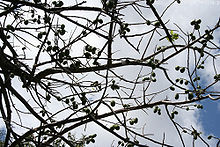Spondias purpurea
| Jocote | |
|---|---|
 |
|
| Scientific classification | |
| Kingdom: | Plantae |
| Clade: | Angiosperms |
| Clade: | Eudicots |
| Clade: | Rosids |
| Order: | Sapindales |
| Family: | Anacardiaceae |
| Genus: | Spondias |
| Species: | S. purpurea |
| Binomial name | |
|
Spondias purpurea L. |
|
Spondias purpurea is a species in flowering plant in the cashew family, Anacardiaceae, that is native to tropical regions of the Americas. It is most commonly known as jocote, which derives from the Nahuatl word xocotl, meaning any kind of sour or acidic fruit. However, this fruit can be particularly sweet when it ripens long enough. Other common names include red mombin, purple mombin,hog plum, ciruela huesito (Venezuela), ciriguela, cirigüela,cirguela, and jobito (Ecuador).
Jocote is a small to medium-sized tree up to 7 m (23 ft) tall. The leaves are deciduous in the short dry season, and only fall shortly before the new leaves develop; they are pinnate, with 7-23 leaflets, each leaflet 3–5 cm long and 1.5–2 cm broad. The flowers are small, reddish-purple, produced in large panicles. The fruit is an edible oval drupe, 3–5 cm long and 2-3.5 cm broad, ripening red (occasionally yellow) and containing a single large seed. The sap and fruit contain urushiol, an oil that causes an allergic rash upon contact with skin.
It is now widely cultivated in tropical regions throughout the world for its edible fruit, and is also naturalised in some areas, including the Philippines and Nigeria. Numerous cultivars have been selected for fruit quality. It is also abundant in Jamaica and Central America. In Florida growth is relegated to near-tropical areas of the state, and the tree is killed or greatly harmed by cold winter temperatures from Palm Beach County northward.
In Ecuador it is propagated by planting trunks. Seedlings are green when not ripe but enjoyed by locals by adding sea salt.The ripe fruit is red and is very sweet to the taste.
...
Wikipedia
